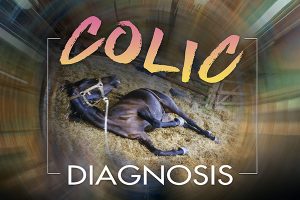Colic Diagnosis Can Save A Horse’s Life
Click here to read the complete article
242 – November/December, 2023
Colic is a general term that simply means abdominal pain. It’s usually a gut problem, but sometimes may be due to other issues. It’s not always easy to make an accurate diagnosis when examining the horse. Sometimes, even with modern technology, we can’t determine exactly what’s wrong, but veterinarians today have many tools that can help figure it out.
Dr. Nora Grenager, an equine internal medicine specialist in Virginia who has a lot of experience with colic cases, says the goal of a colic workup is to identify which part of the GI tract is involved, whether or not surgery is indicated, and the type of colic. “We use a combination of the horse’s history, physical exam findings, abdominal palpation per rectum, presence or absence of nasogastric reflux, ultrasound findings, bloodwork, abdominocentesis and fluid analysis, abdominal radiographs, gastroscopy, and the clinician’s experience. Some of these diagnostics (such as measuring lactate levels) help us determine how critically ill the horse is and possibly indicate a need for surgery, while other tools (such as abdominal ultrasound) can give us specific information,” she says.
A pertinent history of the horse will look at things like recent travel, any feed changes, water access, recent illness, any previous colic, recent medications, activity level and any changes, pregnancy, foaling, etc. Management history will include whether the horse is kept at pasture or a stall, amount of turnout/exercise, weather/climate, feed (pasture, hay, grain, supplements, etc.) and whether any other horses have been affected.
Dr. Melinda Freckleton (Firestar Veterinary Services, in northern Virginia) says one of the greatest tools the veterinarian utilizes is a thorough physical exam. “Checking things like temperature, heart rate, capillary refill time, and the horse’s comfort level are important starting points in order to understand what is seen with any technology.”
Before beginning an exam, the veterinarian will evaluate the degree of pain. It is also important to check heart rate before sedation unless the horse is impossible to restrain because of pain. “We then look at the horse’s gums and mucous membranes and check color (pink versus pale versus toxic/hyperemic), capillary refill time, moist versus tacky/dry,” says Grenager. “This tells us about hydration, perfusion (amount of blood coming to the tissues), or shock,” she says.
Click here to read the complete article
242 – November/December, 2023











